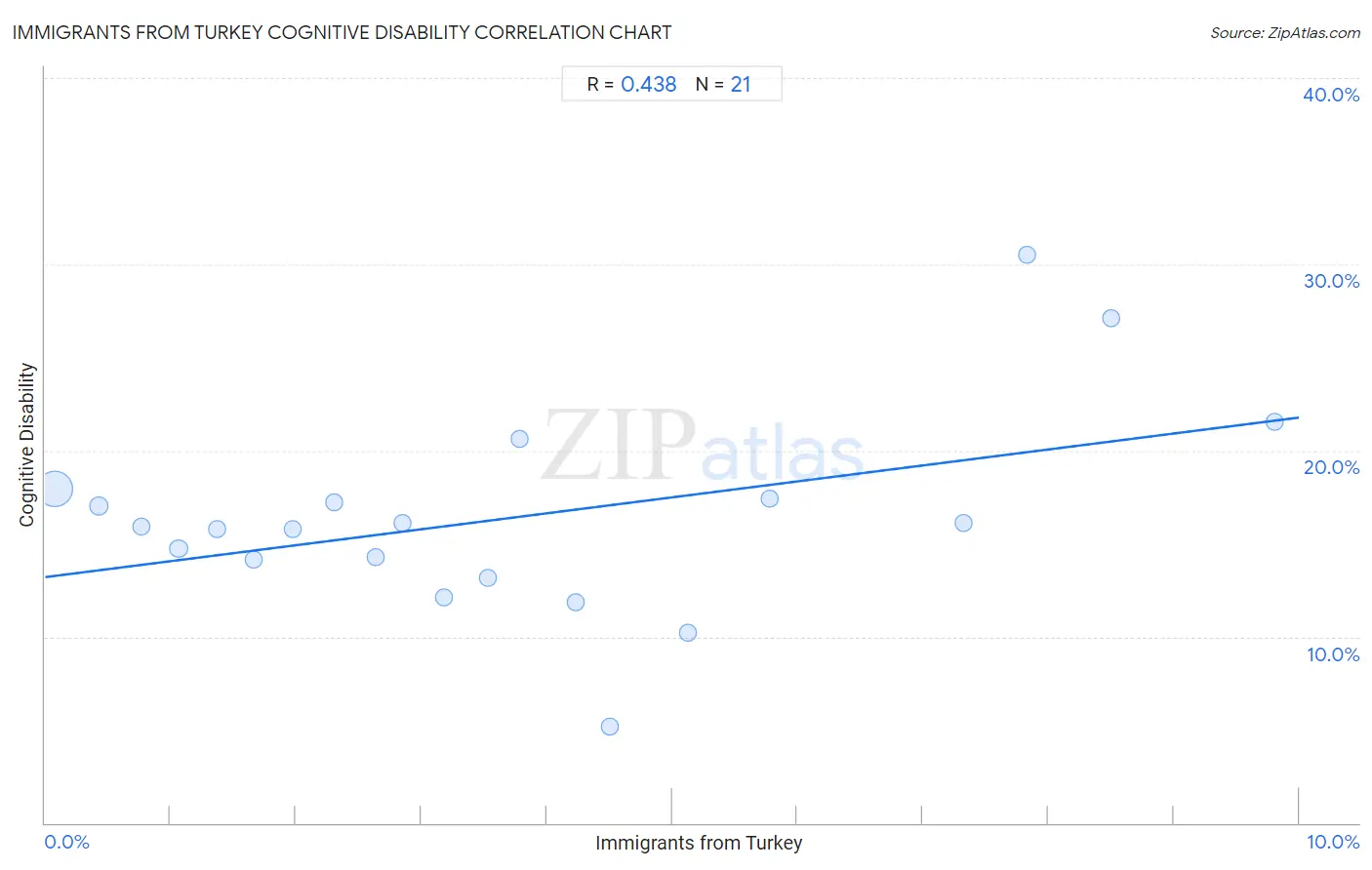Immigrants from Turkey Cognitive Disability
COMPARE
Immigrants from Turkey
Select to Compare
Cognitive Disability
Immigrants from Turkey Cognitive Disability
17.2%
COGNITIVE DISABILITY
56.7/ 100
METRIC RATING
172nd/ 347
METRIC RANK
Immigrants from Turkey Cognitive Disability Correlation Chart
The statistical analysis conducted on geographies consisting of 223,051,603 people shows a moderate positive correlation between the proportion of Immigrants from Turkey and percentage of population with cognitive disability in the United States with a correlation coefficient (R) of 0.438 and weighted average of 17.2%. On average, for every 1% (one percent) increase in Immigrants from Turkey within a typical geography, there is an increase of 0.86% in percentage of population with cognitive disability.

It is essential to understand that the correlation between the percentage of Immigrants from Turkey and percentage of population with cognitive disability does not imply a direct cause-and-effect relationship. It remains uncertain whether the presence of Immigrants from Turkey influences an upward or downward trend in the level of percentage of population with cognitive disability within an area, or if Immigrants from Turkey simply ended up residing in those areas with higher or lower levels of percentage of population with cognitive disability due to other factors.
Demographics Similar to Immigrants from Turkey by Cognitive Disability
In terms of cognitive disability, the demographic groups most similar to Immigrants from Turkey are Tlingit-Haida (17.2%, a difference of 0.080%), Ecuadorian (17.2%, a difference of 0.090%), Immigrants from Portugal (17.2%, a difference of 0.15%), Immigrants (17.2%, a difference of 0.17%), and Immigrants from Northern Africa (17.3%, a difference of 0.18%).
| Demographics | Rating | Rank | Cognitive Disability |
| Immigrants from Albania | 64.9 /100 | #165 | Good 17.2% |
| Immigrants from Ecuador | 64.4 /100 | #166 | Good 17.2% |
| Immigrants from Syria | 63.5 /100 | #167 | Good 17.2% |
| Immigrants | 62.5 /100 | #168 | Good 17.2% |
| Immigrants from Portugal | 61.8 /100 | #169 | Good 17.2% |
| Ecuadorians | 59.6 /100 | #170 | Average 17.2% |
| Tlingit-Haida | 59.4 /100 | #171 | Average 17.2% |
| Immigrants from Turkey | 56.7 /100 | #172 | Average 17.2% |
| Immigrants from Northern Africa | 50.2 /100 | #173 | Average 17.3% |
| Laotians | 50.0 /100 | #174 | Average 17.3% |
| Tsimshian | 49.8 /100 | #175 | Average 17.3% |
| Shoshone | 49.2 /100 | #176 | Average 17.3% |
| Ute | 49.1 /100 | #177 | Average 17.3% |
| Spanish | 48.9 /100 | #178 | Average 17.3% |
| Sioux | 48.6 /100 | #179 | Average 17.3% |
Immigrants from Turkey Cognitive Disability Correlation Summary
| Measurement | Immigrants from Turkey Data | Cognitive Disability Data |
| Minimum | 0.075% | 5.2% |
| Maximum | 9.8% | 30.5% |
| Range | 9.7% | 25.3% |
| Mean | 3.7% | 16.4% |
| Median | 3.2% | 15.9% |
| Interquartile 25% (IQ1) | 1.5% | 13.7% |
| Interquartile 75% (IQ3) | 5.5% | 17.7% |
| Interquartile Range (IQR) | 3.9% | 4.0% |
| Standard Deviation (Sample) | 2.8% | 5.4% |
| Standard Deviation (Population) | 2.7% | 5.3% |
Correlation Details
| Immigrants from Turkey Percentile | Sample Size | Cognitive Disability |
[ 0.0% - 0.5% ] 0.075% | 205,820,897 | 17.9% |
[ 0.0% - 0.5% ] 0.42% | 12,847,639 | 17.0% |
[ 0.5% - 1.0% ] 0.77% | 2,367,487 | 15.9% |
[ 1.0% - 1.5% ] 1.06% | 866,402 | 14.7% |
[ 1.0% - 1.5% ] 1.37% | 308,577 | 15.8% |
[ 1.5% - 2.0% ] 1.67% | 336,176 | 14.1% |
[ 1.5% - 2.0% ] 1.98% | 297,844 | 15.8% |
[ 2.0% - 2.5% ] 2.31% | 63,506 | 17.2% |
[ 2.5% - 3.0% ] 2.63% | 45,390 | 14.3% |
[ 2.5% - 3.0% ] 2.85% | 32,612 | 16.1% |
[ 3.0% - 3.5% ] 3.18% | 7,619 | 12.1% |
[ 3.5% - 4.0% ] 3.53% | 11,204 | 13.2% |
[ 3.5% - 4.0% ] 3.78% | 17,240 | 20.6% |
[ 4.0% - 4.5% ] 4.23% | 2,740 | 11.8% |
[ 4.5% - 5.0% ] 4.51% | 2,440 | 5.2% |
[ 5.0% - 5.5% ] 5.12% | 5,798 | 10.2% |
[ 5.5% - 6.0% ] 5.78% | 11,458 | 17.4% |
[ 7.0% - 7.5% ] 7.32% | 5,476 | 16.1% |
[ 7.5% - 8.0% ] 7.83% | 702 | 30.5% |
[ 8.5% - 9.0% ] 8.50% | 294 | 27.1% |
[ 9.5% - 10.0% ] 9.80% | 102 | 21.6% |